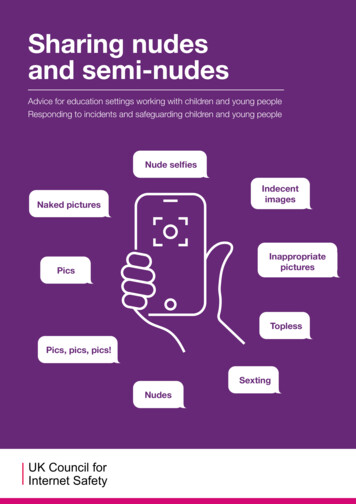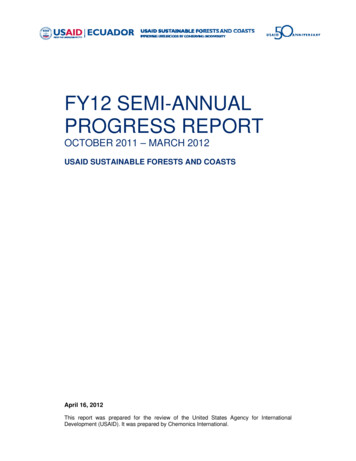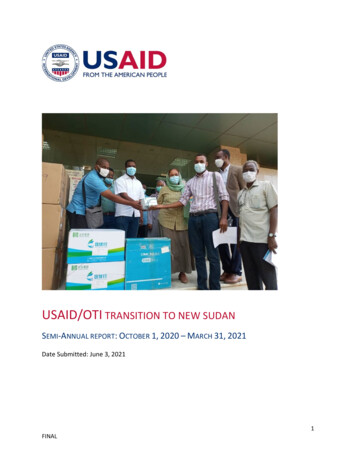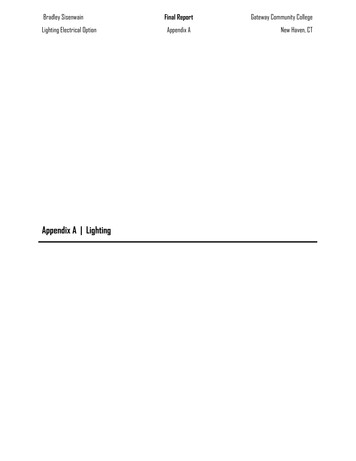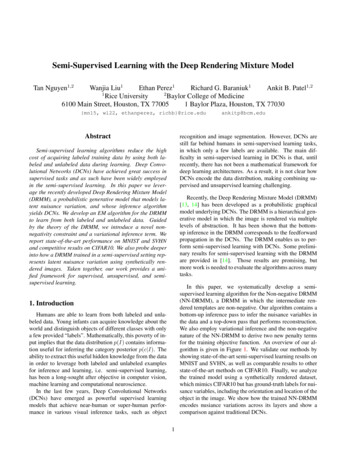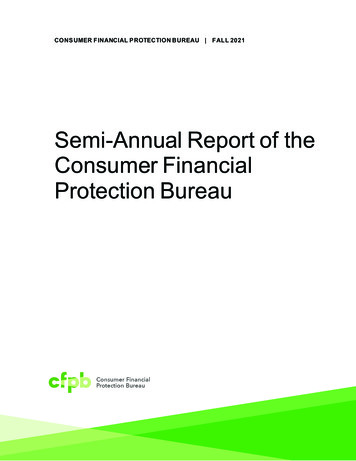
Transcription
CONS UMER FINANCIAL P ROTECTION BUREAU FALL 2021Semi-Annual Report of theConsumer FinancialProtection Bureau
Table of ContentsTable of Contents .1Division Reporting.2Consumer Education and External Affairs. 2Office of Equal Opportunity and Fairness . 11Operations. 22Research, Markets and Regulations . 29Supervision, Enforcement and Fair Lending . 45Appendix .87Annual report on the Truth in Lending Act, the Electronic Fund Transfer Act,and the Credit Card Accountability Responsibility and Disclosu re Act. 87Public enforcement actions and reimbursements – TILA, EFTA,CARD Act .88TILA: Public enforcement actions and reimbursements . 88EFTA: Public enforcement actions and reimbursements . 91CARD Act: Public enforcement actions and reimbursements . 96Outreach related to TILA and EFTA.98List of Director remarks from speaking engagements during the reportingperiod . 99Congressional en gagemen t activity. 1001SEMI-ANNUAL REPORT OF THE CONSUMER FINANCIAL PROTECTION BUREAU FALL 2021
Division ReportingConsumer Education and External AffairsThe Consumer Education and External Affairs (CEEA) Division seeks to protect and promotethe financial well-being of consumers and strengthen the CFPB’s work and impact through broadand consistent engagement with the public.Significant problems faced by consumers in shopping for orobtaining consumer financial products or services The effect of the COVID-19 pandemic on accuracy in tenant screening reports. Incomeshocks from the COVID-19 pandemic contributed to an increase in housing and financialinsecurity for many households, particularly for renters. 1 Some data and estimatesindicated that millions of renter households were at risk of eviction over the course of thepandemic. 2 Federal, state, and local actions were taken to alleviate the rental housingrelated impacts of the pandemic. However, public reports as well as complaints to theCFPB indicated that some tenants were being evicted in violation of applicablemoratoria. Consumers also expressed concern about questionable debt collectionactivities following eviction. 3 The CFPB is concerned all of these factors are likely tolead to an increase in negative rental information in the consumer reporting system,which, combined with an increase in the number of consumers seeking new rentalhousing, could create new risks that inaccurate negative rental information will beincluded in tenant screening reports and such inaccuracies could impair the ability ofrenters, negatively impacted by the pandemic, to secure new rental housing and otherwiserecover from the pandemic’s economic effects.In response, the CFPB issued an enforcement compliance bulletin noting that the CFPBwill continue to look carefully at consumer reporting agencies’ and furnishers’compliance with the FCRA accuracy obligations relating to rental information, cfpb Housing insecurity and the COVID-19 r Fin. Prot. Bureau, Complaint Bulletin: COVID-19 issues described in consumer complaints (July s/cfpb covid-19-issues-described-consumercomplaints complaint-bulletin 202107.pdf (CFPB Complaint Bulletin).2SEMI-ANNUAL REPORT OF THE CONSUMER FINANCIAL PROTECTION BUREAU FALL 2021
outlined specific areas of focus and concern. 4 The CFPB also issued a consumer-facingblog entitled, Errors in your tenant screening report shouldn’t keep you from finding aplace to call home, as well as new consumer education content to help consumersunderstand their tenant screening reports and how to dispute and correct errors.5 Consumer use of Buy Now, Pay Later products. Public reports have indicated a dramaticincrease in the number of consumers using Buy Now, Pay Later products, particularly foronline purchases. 6 Some reports have also indicated that some consumers are strugglingto make payments on time, resulting in late fees; 7 experiencing a drop in their credit scoreafter using these products; 8 facing difficulties returning goods purchased using a BNPLproduct; 9 and are potentially unaware that these products lack some consumer protectionsprovided by credit cards. 10 In July 2021, the CFPB published a blog for consumersentitled, Should you buy now and pay later? 11 The blog describes how these productswork, in general, and benefits and risks that consumers should consider before decidingwhether to use such a product. The blog also included specific information forservicemembers as part of Military Consumer Protection Month. 12Credit and consumer reporting. From January 2020 to September 2021, the CFPBreceived more than 800,000 credit or consumer reporting complaints. Of thesecomplaints, more than 700,000 were submitted about Equifax, Experian, or TransUnion.Complaints submitted about these companies accounted for more than 50 percent of allcomplaints received by the CFPB in 2020 and more than 60 percent in 2021. In theircomplaints to the CFPB, consumers describe harms stemming from their failed attemptsto correct incomplete and inaccurate information on their credit reports (e.g., consumersare caught in an automated system where they are unable to have their problemaddressed; consumers waste time, energy, and money to try to correct their reports). In4 https://files.consumerfinance.gov/f/documents/cfpb consumer-reporting-rental-information bulletin-2021-03 ay-later/.12Additional activity has occurred since the end of the reporting period. More information can be found here: Know before youbuy (now, pay later) this holiday season Consumer Financial Protection Bureau (consumerfinance.gov).3SEMI-ANNUAL REPORT OF THE CONSUMER FINANCIAL PROTECTION BUREAU FALL 2021
January 2022, the CFPB published the annual report of credit and consumer reportingcomplaints. 13 This report analyzed how Equifax, Experian, and TransUnion respond tocomplaints, including complaints they are required to respond to under the Fair CreditReporting Act (FCRA).Significant initiatives 144Appraisal Bias. On June 15, 2021, the CFPB hosted a roundtable examining racial bias inhome appraisals. The roundtable included participants from partner agencies, includingthe National Credit Union Administration (NCUA), the Office of the Comptroller of theCurrency (OCC), and the Department of Housing and Urban Development (HUD). Alsoparticipating in the roundtable were experts who spoke about how unconscious biases canplay out in the appraisal process as well as civil rights activists, consumer advocates, andlocal leaders who described the biases they see in their communities every day. Theyoffered valuable insights and creative ideas, sparking important conversations across theFederal government about how we can work together with stakeholders to tackle racialbias and other inequities in housing.Housing Insecurity – Public Awareness and Education Campaign. 14 During the reportingperiod, the CFPB’s housing insecurity efforts expanded into a comprehensive, crossfederal campaign aimed at connecting homeowners and renters facing housing insecuritydue to the COVID-19 pandemic with the resources available to help them stay in theirhomes. The CFPB continued its partnership with the Department of Agriculture, theDepartment of Housing and Urban Development, the Department of the Treasury, theDepartment of Veterans Affairs, and the Federal Housing Finance Agency on a federalinteragency Housing Portal within ConsumerFinance.gov. Resources include informationon forbearance, foreclosure, eviction prevention, and specific action consumers can taketo utilize protections to stay in their homes. The Housing Portal received regularenhancements as legal protections changed, key deadlines shifted, and user researchhighlighted ways the CFPB could improve its offerings to consumers in need, ultimatelycreating ConsumerFinance.gov’s most visited material. In July 2021, the CFPB launcheda Rental Assistance Finder Tool to help consumers find their local programs disbursingemergency rental assistance made available through the Consolidated Appropriations Act(2021) and the American Rescue Plan Act of 2021. The launch of this tool was the mostsuccessful product launch in the CFPB’s history; in only two months (when the reportingperiod for this report closes) users engaged the tool through more than 3.1 /mortgage-and-housing-assistance/.SEMI-ANNUAL REPORT OF THE CONSUMER FINANCIAL PROTECTION BUREAU FALL 2021
sessions to find local programs. Since its inception in May 2020, the Housing Portal hasseen over 5.25M unique users. The Housing Portal has also been translated into six nonEnglish languages (Spanish, Arabic, Korean, Tagalog, Traditional Chinese, Vietnamese). 15COVID-19 Consumer Information.15 Since the onset of the COVID-19 pandemic, theCFPB has published a collection of education resources to help consumers protectthemselves financially during the health crisis. The CFPB created a microsite atConsumerFinanace.gov/coronavirus to help consumers quickly find accurate and up-todate COVID-19 related resources. Topics covered include mortgages, rental assistance,credit reporting, debt collection, student loans, frauds and scams, retirement funds,economic impact payments and more. The CFPB also published resources for specificaudiences such as servicemembers and veterans, older adults and their families, smallbusiness owners, parents, and kids, and more. Additionally, since the beginning of thepandemic, the CFPB has produced 33 COVID-19 related videos; 1,127 social mediamessages with a reach of 93,189,000; and over 325 translations of blogs and web contentinto other languages. During the reporting period, approximately 7 million users accessedthe CFPB’s educational web content in response to COVID-19 – accounting for morethan one quarter of all these users that accessed ConsumerFinance.gov during this time.These users generated 3.1 million engagements and more than 13 million pageviews.Friends and Family Exchanges Toolkit. The COVID-19 pandemic caused financialhardship for millions of Americans, forcing many to turn to family and friends for help.Many families rely on informal lending and borrowing arrangements to weather thestorm, especially in acute financial emergencies or when there is a lack of availableassistance from lending institutions. To support financial educators helping clientsthrough these often-sensitive conversations about these arrangements, the CFPB releasedthe Friends and Family Exchanges Toolkit, a four-part guide for coaching clients inasking for financial help or changing an existing agreement due to their own financialhardship. Based in research and tested with educators, the guide is available for downloadfrom the CFPB website.Financial Literacy Annual Report.16 The CFPB reports annually on its statutory missionto conduct financial education programs and to ensure consumers receive timely andunderstandable information to make responsible decisions about financial transactions.The 2020 report highlights the CFPB’s financial education programs and virus/.16 /5SEMI-ANNUAL REPORT OF THE CONSUMER FINANCIAL PROTECTION BUREAU FALL 2021
Your Money, Your Goals.17 The CFPB continued to disseminate financial empowermentresources to consumers and stakeholders, and provide training on its interactive YourMoney, Your Goals (YMYG) digital and print resources. Training was offered to a widearray of public sector and non-profit organizations, focusing on emerging issues as aresult of the COVID-19 crisis such as credit protection, debt management, financialplanning, rental assistance, accessing CARES Act benefits and more; resources were alsoused by the CFPB for direct-to-consumer outreach. A training page entitled Videos toSpark Action shares engaging and brief training videos rooted in the YMYG toolkit, suchas How Do I Get a Copy of My Credit Report? 18 The YMYG materials include issuesfocused booklets that are consumer-facing such as Behind on Bills?; 19 the financialempowerment toolkit that includes several modules such as Dealing with Debt; andcompanion guides to the toolkit for special populations, such as Focus on NativeCommunities. 20 New materials released include 11 individual digital tools in Spanish anda new companion guide for military communities. Updated materials include Focus onReentry: Criminal Justice, 21 a companion guide with complementary digital tools andtraining materials to assist those working with people with criminal records. YMYGpublications can be easily accessed through the ConsumerFinance.gov website, and freeprint copies are available for order.22Appraisal and Valuation Bias. On Wednesday, November 3, 2021, the CFPB hosted avirtual Consumer Advisory Board (CAB) meeting via WebEx. During this meeting,Board members met to discuss appraisal and Valuation Bias. For this one-hour longsession, CFPB staff from the Office of Fair Lending and Equal Opportunity, along withthe Office of Markets, provided an overview of the CFPB’s current work related toAppraisal and Valuation Bias. The CFPB looked to receive the Board’s perspective onhow the CFPB can help to eliminate racial bias in home valuations, including currenttrends that are being seen in the use of automated valuation models (AVM) and remediesor solutions that are being seen that could help to address and eliminate potentialvaluation bias both for in-person appraisals and AVMs. 2317 /CFPBPubs/CFPBPubs.php?PubID 13272&PHPSESSID ic71h6c6025t3mi0rj9ldg5gi523November 2021 Consumer Advisory Board Meeting Consumer Financial Protection Bureau (consumerfinance.gov)6SEMI-ANNUAL REPORT OF THE CONSUMER FINANCIAL PROTECTION BUREAU FALL 2021
Back-End Fees in Consumer Financial Products and Services. On January 26, 2022, theCFPB launched an initiative to reduce fees that consumers are charged by banks andfinancial companies. CFPB’s research has found several areas where back-end fees mightobscure the true cost of a product and undermine a competitive market. For example, in2019, the CFPB released research finding that the major credit card companies chargedmore than 14 billion each year in punitive late fees; and in 2019, bank revenue fromoverdraft and non-sufficient funds fees surpassed 15 billion. The CFPB is seeking to useits authorities to seek input from the public on experiences with back-end fees associatedwith banks, credit unions, prepaid accounts, credit card accounts, mortgages, loans andpayment transfers.24Justice-Involved Individuals and the Consumer Financial Marketplace. From arrest toincarceration and reentry, people who come into contact with the justice system areconfronted with numerous financial challenges. These challenges include financialproducts and services that may contain exploitative terms and features, offer little or noconsumer choice, and that can have long-term negative consequences for the affectedindividuals and families. The CFPB will issue a report outlining some of the challengesfaced by justice-involved people and their families in navigating their finances at eachstage of the criminal justice system. These challenges raise serious questions about thetransparency, fairness, and availability of consumer choice in markets associated with thejustice system, as well as demonstrating the pervasive reach of predatory practicestargeted at justice-involved individuals and their families. 25Complaint analysisComplaints give the CFPB and others insights into problems people are experiencing in themarketplace and help the CFPB regulate consumer financial products and services under existingfederal consumer financial laws, enforce those laws judiciously, and educate and empowerconsumers to make informed financial decisions.During the period October 1, 2020, through September 30, 2021, the CFPB receivedapproximately 872,400 consumer complaints.26 This represents an approximately 33 percent24Additional activity has occurred with this matter since the end of the reporting period. Additional information can be foundhere: dditional activity has occurred with this matter since the end of the reporting period. Additional information can be foundhere: Justice-Involved Individuals and the Consumer Financial Marketplace (consumerfinance.gov).26This analysis excludes multiple complaints submitted by a given consumer on the same issue and whistleblower tips. For moreinformation on our complaint process refer to the CFPB’s website at 7SEMI-ANNUAL REPORT OF THE CONSUMER FINANCIAL PROTECTION BUREAU FALL 2021
increase from the prior reporting period.27 Consumers submitted approximately 94 percent ofthese complaints through the CFPB’s website and 3 percent via telephone calls. Referrals fromother state and federal agencies accounted for 2 percent of complaints. Consumers submitted theremainder of complaints by mail, email, and fax.The CFPB sent approximately 721,500 (83 percent) of complaints received to companies forreview and response. Companies responded to approximately 98 percent of complaints that theCFPB sent to them for response during the period. The remaining complaints were eitherpending response from the company at the end of the period or did not receive a response. 28Companies’ responses typically include descriptions of steps taken or that will be taken inresponse to the consumer’s complaint, communications received from the consumer, any followup actions or planned follow-up actions, and a categorization of the company’s response.Companies’ responses also describe a range of monetary and non-monetary relief. Examples ofnon-monetary relief include correcting inaccurate data provided or reported in consumers’ creditreports; stopping unwanted calls from debt collectors; correcting account information; issuingcorrected documents; restoring account access; and addressing formerly unmet customer serviceissues.When consumers submit complaints, the CFPB’s complaint form prompts them to select theconsumer financial product or service with which they have a problem as well as the type ofproblem they are having with that product or service. The CFPB uses these consumer selectionsto group the financial products and services about which consumers complain to the CFPB forpublic reports. As shown in Figure 1, credit or consumer reporting was the most complainedabout consumer financial product or service during the period, followed by debt collection.27The prior reporting period, April 1, 2020 through March 31, 2021, reported 656,200 consumer complaints. See Consumer Fin.Prot. Bureau, Semi-Annual Report Spring 2021 (October 2021), available at protection-bureau/28The CFPB referred 7 percent of the complaints it received to other regulatory agencies and found 8 percent to be incomplete.At the end of this period, 0.3 percent of complaints were pending with the consumer and 2 percent were pending with theBureau. Percentages in this section of the report may not sum to 100 percent due to rounding.8SEMI-ANNUAL REPORT OF THE CONSUMER FINANCIAL PROTECTION BUREAU FALL 2021
FIGURE 1Consumer Response analyzes consumer complaints, company responses, and consumer feedbackto assess the accuracy, completeness, and timeliness of company responses so that the CFPB,other regulators, consumers, and the marketplace have relevant information about consumers’challenges with financial products and services. Consumer Response uses a variety ofapproaches to identify trends and possible consumer harm. Examples include: Reviewing cohorts of complaints and company responses to assess the accuracy,timeliness, and completeness of an individual company’s responses to complaints sent tothem for response; Conducting text analytics to identify emerging trends and statistical anomalies; and Visualizing data to highlight geographic and temporal patterns.The CFPB publishes periodic reports about its complaint analyses. Notable among these is theConsumer Response Annual Report, which was published on March 24, 2021 and is required bySection 1013(b)(3)(C) of the Dodd-Frank Act. This report analyzed complaints submitted incalendar year 2020 about a variety of consumer financial products and services and includedobservations about issues consumers experienced related to the coronavirus pandemic. 29The CFPB makes complaint data available to the public in the Consumer Complaint Database(Database). The Database contains certain de-identified, individual complaint level data, as ch/research-reportsSEMI-ANNUAL REPORT OF THE CONSUMER FINANCIAL PROTECTION BUREAU FALL 2021
as dynamic visualization tools, including geospatial and trend views based on recent complaintdata to help users of the database understand current and recent marketplace conditions.Finally, the CFPB also shares consumer complaint information with prudential regulators, theFederal Trade Commission, other federal agencies, and state agencies.10SEMI-ANNUAL REPORT OF THE CONSUMER FINANCIAL PROTECTION BUREAU FALL 2021
Office of Equal Opportunity and FairnessSignificant initiatives 11The Office of Minority and Women Inclusion (OMWI) is leading the CFPB’s voluntaryresponse to Executive Order 13985 (racial and economic equity) and guidance from theWhite House Domestic Policy Council and on April 20, 2021, submitted a 90-dayprogress report to OMB.In alignment with Executive Order 13985, and guidance from the White House DomesticPolicy Council, the CFPB voluntarily submitted a 200-day equity assessment report toOMB on August 6, 2021.The OMWI Director, as the CFPB’s Chief Diversity Officer, is leading the CFPB’svoluntary response to Executive Order (EO) 14035 (diversity, equity, inclusion, andaccessibility - DEIA) and is leading a cross-agency DEIA Team to facilitate thedevelopment of a 5-year DEIA Strategic Plan for the CFPB.The CFPB also continued to work on completing action items to eliminate barriers toequal employment opportunity for Black and Hispanic employees and applicants whichwill be expanded upon in the FY 2021 EEO Status Report (MD-715 Report).In September 2021, the CFPB developed an action plan to address and eliminate barriersto equal employment opportunity identified for persons with a disability and additionalinformation will be published in the FY 2021 EEO Status Report (MD-715 Report).In January 2021, the CFPB issued a Statement to encourage financial institutions to betterserve consumers with limited English proficiency (LEP) and to provide principles andguidelines to assist financial institutions in complying with the Dodd-Frank Act, EqualCredit Opportunity Act (ECOA), and other applicable laws.In October 2021, the CFPB submitted a DEIA self-assessment to the Office ofManagement and Budget (OMB) as part of the CFPB’s voluntary response to EO 14035(DEIA).The Office of Fair Lending led the CFPB’s involvement in the Interagency Task Force onProperty Appraisal and Valuation Equity (PAVE), a task force focusing on issues of biasin home appraisals. During the reporting period, the CFPB hosted a roundtable to hearfrom stakeholders and participants from partner agencies to look closer at the role of biasin home appraisals. The Office of Fair Lending expects to continue to participate in thistask force to address appraisal bias during the upcoming reporting period.SEMI-ANNUAL REPORT OF THE CONSUMER FINANCIAL PROTECTION BUREAU FALL 2021
The CFPB is currently developing its 5-year DEIA Strategic Plan. OMWI is workingcollaboratively with representatives from business units across the CFPB, including theOffice of Human Capital, the Office of Civil Rights, the Disability and AccessibilityProgram Section, Legal, Technology and Innovation, and Administrative Operations, todevelop the DEIA Strategic Plan. The plan is in alignment with EO 14035 (DEIA). TheDEIA Strategic Plan is in alignment with and is referenced in the CFPB’s overallStrategic Plan.On November 22, 2021, the CFPB was one of three agencies highlighted in the WhiteHouse Domestic Policy Council’s Diversity, Equity, Inclusion and Accessibility (DEIA)initiative webinar titled “Promising Practices from Agencies.” The CFPB presented onthe outstanding work it has done to promote LGBTQ equity and inclusion within theCFPB and best practices other agencies can adopt.In January 2022, the CFPB will submit its Equity Action Plan, that aligns with EO 13985(Racial Equity). In February 2022, the CFPB will submit its annual EEO Status Report(MD-715 Report). In March 2022, the CFPB will submit its DEIA Strategic Plan, thataligns with the Government-Wide Strategic Plan, to OMB. The CFPB will also submit itsNo FEAR Act Annual Report and OMWI Annual Report to Congress. In April 2022, theCFPB will submit its Annual Fair Lending Report.Efforts to increase workforce and contracting diversityconsistent with procedures established by OMWIDuring the reporting period, CFPB continued its work to advance diversity and inclusion underthe mandates of Section 342 of the Dodd-Frank Act.The CFPB continued to execute the objectives and strategies outlined in the Diversity andInclusion Strategic Plan Update FY 2019–2022,30 which complements the CFPB’s overallStrategic Plan FY 2018–2022.31Specifically, Objective 3.2 of the CFPB’s Strategic Plan commits the CFPB to “maintain atalented, diverse, inclusive and engaged workforce.” The plan requires the CFPB to achieve thisobjective with specific strategies, which plan/SEMI-ANNUAL REPORT OF THE CONSUMER FINANCIAL PROTECTION BUREAU FALL 2021
Establish and maintain human capital policies and programs to help the agencyeffectively and efficiently manage a talented, diverse, and inclusive workforce.Offer learning and development opportunities that foster a climate of professional growthand continuous improvement.Develop human capital processes, tools, and technologies that continue to support thematuration of the CFPB and the effectiveness of human resource operations.Build a positive work environment that engages employees and enables them to continuedoing their best work.Maintain comprehensive equal employment opportunity compliance and diversity andinclusion programs, including those focused on minority and women inclusion.As of September 2021, an analysis of the CFPB’s current workforce reveals the following keypoints: Women represent 50 percent of the CFPB’s workforce in 2021.Minorities (Hispanic, Black, Asian, Native Hawaiian/Other Pacific Islander, AmericanIndian/Alaska Native, and employees of two or more races) represent 43 percent of theCFPB workforce in 2021 with a 2 percent increase from FY 2020.As of September 30, 2021, 15 percent of CFPB employees on permanent appointmentsidentified as individuals with a disability. Of the permanent workforce, 3 percent ofemployees identified as individuals with a tar
servicemembers as part of Military Consumer Protection Month. 12 Credit and consumer reporting. From January 2020 to September 2021, the CFPB received more than 800,000 credit or consumer reporting complaints. Of these complaints, more than 700,000 were submitted about Equifax, Experian, or TransUnion.




